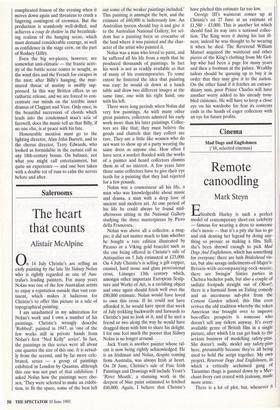Salerooms
The heart that counts
Alistair McAlpine
On 14 July Christie's are selling an early painting by the late Sir Sidney Nolan who is rightly regarded as one of Aus- tralia's leading painters. For many years Nolan was one of the few Australian artists to enjoy a reputation outside that vast con- tinent, which makes it ludicrous for Christie's to offer this picture in a sale of topographical painting.
I am unashamed in my admiration for Nolan's work and I own a number of his paintings. Christie's wrongly describe 'Robbed', painted in 1947, as 'one of the few works still in private hands from Nolan's first "Ned Kelly" series'. In fact, the paintings in this series were all about one quarter the size of this one. It is actual- ly from the second, and by far more cele- brated, series — a group of paintings exhibited in London by Quantas, although this one was not part of that exhibition. I asked Nolan how the paintings were cho- sen, 'They were selected to make an exhibi- tion, to fit the space, some of the best left out some of the weaker paintings included.' This painting is amongst the best, and the estimate of £60,000 is ludicrously low. An Australian tycoon should buy it and give it to the Australian National Gallery, for sel- dom has a painting been so evocative of the land where it was painted and the char- acter of the artist who painted it.
Nolan was a man who loved to paint, and he suffered all his life from a myth that he produced thousands of paintings. In fact his work is not as readily available as that of many of his contemporaries. To some extent he fostered the idea that painting was easy: he would sit down at a lunch table and draw two different images at the same time, one with his right hand, one with his left.
There were long periods when Nolan did very few paintings. As with many other great painters, collectors admired his early work more than his later paintings. Collec- tors are like that; they must believe the goods and chattels that they collect are rare. They are a little like women who do not want to show up at a party wearing the same dress as anyone else. How often I have seen a market flooded with the works of a painter and heard collectors dismiss them as of no interest. A few years later those same collectors have to give their eye teeth for a painting that they had rejected for a few pounds.
Nolan was a connoisseur all his life, a man who was knowledgeable about music and drama, a man with a deep love of ancient and modern art. At one period of his life he could always be found mid- afternoon sitting in the National Gallery studying the three masterpieces by Piero della Francesca.
Nolan was above all a collector, a mag- pie; it did not matter much to him whether he bought a rare edition illustrated by Picasso or a Viking gold bracelet such as the one being offered in Christie's sale of Antiquities on 5 July estimated at £25,000.
On 4 July Christie's is selling a gilt copper, enamel, hard stone and glass processional cross, Limoges 13th century which, amongst other important European Sculp- ture and Works of Art, is a ravishing object and once again should fetch well over the £80,000 estimate. Nolan would have loved to own this cross. If he could not have afforded it, he would have spent that week of July trekking backwards and forwards to Christie's just to look at it, and if he met a friend or two along the way he would have dragged them with him to share his delight. I for one feel much the poorer that Sidney Nolan is no longer around.
Jack Yeats is another painter whose tal- ent is now being rightly acknowledged. He is an Irishman and Nolan, despite coming from Australia, was always Irish at heart. On 28 June, Christie's sale of Fine Irish Paintings and Drawings will include Yeats's 'River Mouth', a stunning work in the deepest of blue paint estimated to fetched £60,000. Again, I believe that Christie's have pitched this estimate far too low.
George III's waistcoat comes up at Christie's on 27 June at an estimate of £1,500 - £3,000. This is another lot which should find its way into a national collec- tion. The King wore it during his last ill- ness; indeed he was thought to be wearing it when he died. The Reverend William Mansel acquired the waistcoat and other pieces of the King's clothing from Mr Gol- lop who had been a page for many years and then a footman at the palace. Wealthy tailors should be queuing up to buy it in order that they may give it to the nation. On the other hand if it fetches an extraor- dinary sum, poor Prince Charles will have another worry added to his already trou- bled existence. He will have to keep a close eye on his wardrobe for fear its contents ends in the hands of eager collectors with an eye for future profits.


































































 Previous page
Previous page